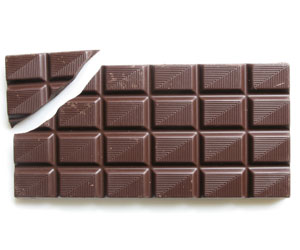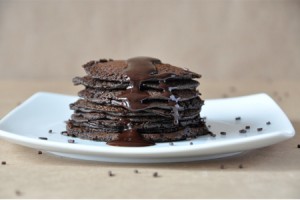Chocolate is one of my very favorite foods. Chocolate ice cream, truffles, dark chocolate bars – I love it in all forms. And contrary to what some might think, chocolate is actually very healthy – that is, when eaten in the right forms and in moderate amounts.
After all, not all chocolate is created equal – you won’t reap the same health benefits from a Mars Bar that you would from a few squares of antioxidant-rich dark chocolate. So before you consider this article a license to go on an all-out candy binge, know the facts first and then proceed with your chocolate-loving habits.
What is chocolate? First, the egg before the chicken. Chocolate is derived from cocao beans, which are the seeds of the fruit from the cacao tree. The Aztecs were thought hold the cocoa bean in high value and even used it as currency.
To get from bean to bar, the cacao beans are roasted, cracked, and winnowed into what we commonly know as cacao nibs. The nibs are then crushed into a thick paste called chocolate liquor (which, ironically, contains no alcohol), and then added to a mixture of sugar, cocoa butter, milk and vanilla. And that, my friends, is how your Snicker’s bar came to be.
Health benefits: For one, chocolate is one of the top antioxidant containing foods around, beating out top-ranking prunes, blackberries and even blueberries. Chocolate is also rich in various vitamins and minerals, including iron, coper and potassium, and has been found to reduce the risk of stroke, specifically in women who ate more than 45 grams of chocolate per week. Chocolate has also been shown to lower blood pressure, bad cholesterol and the risk of heart disease.
Dark chocolate, specifically has anti-inflammatory properties and is also rich in fiber, which means it keeps you full longer so you’ll eat less. And another stunner? An Italian study in 2005 showed that people who ate chocolate regularly increased their insulin sensitivity, therefore lowering their risk for diabetes. Is there anything chocolate can’t do?
Nutritional stats: One ounce of dark chocolate contains approximately 150 calories, 10 grams of fat, 6 grams of saturated fat, 13 grams of carbohydrates, 3.1 grams of dietary fiber, and 1.7 grams of protein.
One ounce of milk chocolate contains approximately 157 calories, 10 grams of fat, 6 grams of saturated fat, 15 grams of carbohydrates, 3.1 grams of dietary fiber, and 1.7 grams of protein.
Cooking methods: Raw cocoa beans have an intense and extremely bitter taste, so raw consumption is not recommended. However, once properly processed, chocolate can be used in a variety of dishes both sweet and savory, including cakes, pies, beverages, cookies, Mexican moles, meat rubs and soups.
Recipes:
Vegan Black Bean Brownie Pancakes
We’ve got you covered in all things chocolate – no pun intended – from breakfast to dessert and even dinner with the vegetarian chocolate chili. Now go forth and eat chocolate – after all, it’s the healthy thing to do.
